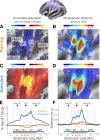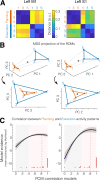Motor planning brings human primary somatosensory cortex into action-specific preparatory states
- PMID: 35018886
- PMCID: PMC8786310
- DOI: 10.7554/eLife.69517
Motor planning brings human primary somatosensory cortex into action-specific preparatory states
Abstract
Motor planning plays a critical role in producing fast and accurate movement. Yet, the neural processes that occur in human primary motor and somatosensory cortex during planning, and how they relate to those during movement execution, remain poorly understood. Here, we used 7T functional magnetic resonance imaging and a delayed movement paradigm to study single finger movement planning and execution. The inclusion of no-go trials and variable delays allowed us to separate what are typically overlapping planning and execution brain responses. Although our univariate results show widespread deactivation during finger planning, multivariate pattern analysis revealed finger-specific activity patterns in contralateral primary somatosensory cortex (S1), which predicted the planned finger action. Surprisingly, these activity patterns were as informative as those found in contralateral primary motor cortex (M1). Control analyses ruled out the possibility that the detected information was an artifact of subthreshold movements during the preparatory delay. Furthermore, we observed that finger-specific activity patterns during planning were highly correlated to those during execution. These findings reveal that motor planning activates the specific S1 and M1 circuits that are engaged during the execution of a finger press, while activity in both regions is overall suppressed. We propose that preparatory states in S1 may improve movement control through changes in sensory processing or via direct influence of spinal motor neurons.
Keywords: fMRI; finger control; human; motor planning; neuroscience; representational geometry; sensorimotor cortex.
© 2022, Ariani et al.
Conflict of interest statement
GA No competing interests declared, JP, JD Reviewing editor, eLife
Figures








References
Publication types
MeSH terms
LinkOut - more resources
Full Text Sources

